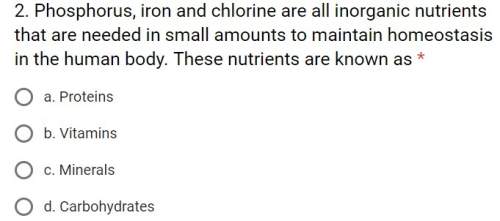
Biology, 06.10.2019 12:00 thatkiddrew4063
In which phase(s) of matter are the atoms closely packed but still able to slide past each other?

Answers: 1
Another question on Biology

Biology, 21.06.2019 18:00
1. the passing of is the basis of heredity. 2. our encode the instructions that define our traits. 3. each of us has thousands of genes, which are made of and reside in our chromosomes. 4. in addition to our genes, the we live in also define our traits. 5. humans have two complete sets of chromosomes. 6. when parents conceive a child, each parent contributes set of chromosomes. 7. every child receives of its chromosomes from the mother and half from the father. 8. this transfer takes place at when the father’s sperm joins the mother’s egg. 9. while most cells in our bodies have two sets of chromosomes, or a total of egg and sperm each have chromosomes. 10. when egg and sperm unite they create a single cell called a 11. each parent contributes complete set of chromosomes to their child. 12. since the parents contribute the chromosomes to each new child, every child inherits a unique set of chromosomes. 13. as a result, every baby will have a combination of traits.
Answers: 1

Biology, 21.06.2019 20:30
Chapter 11.1 & 11.2 notes section 11.1 1. every living thing has a set of ? inherited from its parents. 2. after becoming a ? , mendel spent several years studying ? and mathematics at the university of vienna. 3. during sexual reproduction, male and female reproductive cells join, a process known as ? . 4. pea flowers are normally ? , which means that sperm cells in pollen fertilize the egg cells in the ? flowers. 5. when mendel crossed plants with ? characters for the same trait, the resulting offspring had only one of the characters. 6. a ? is a specific characteristic, such as seed color or plant height, that varies from one individual to another. 7. filius and filia are the latin words for ? and ? . 8. the offspring of crosses between parents with different traits are called ? . 9.to mendel's surprise, all of the offspring had the character of only ? of the parents. 10. mendel's first conclusion was that biological inheritance is determined by ? that are ? from one generation to the next. 11. scientist calls the chemical factors that determine traits ? . 12. mendel's second conclusion is the ? . 13. the principle of dominance states that some alleles are ? and others are ? . 14. when mendel allowed the f1 plants to reproduce by self-pollination the traits controlled by ? alleles reappeared in about ? of the f2 plants in each cross.
Answers: 1

Biology, 21.06.2019 22:00
Protein synthesis actually begins in the nucleus when transcribes a single gene on the dna molecule is copied. the process of copying this gene is called this copy is known as and contains the protein building instructions. this copy is sent out into the cytoplasm to the part of the cell known as the the of the ribosome will join together to form a functional ribosome when they attach to the mrna. as the mrna moves through the ribosome, the message is read by transfer rna brings the correct back to the ribosome. the amino acids are placed in the correct order and are hitched together by
Answers: 3

You know the right answer?
In which phase(s) of matter are the atoms closely packed but still able to slide past each other?...
Questions


Chemistry, 25.08.2019 02:30

Biology, 25.08.2019 02:30


Mathematics, 25.08.2019 02:30

Social Studies, 25.08.2019 02:30

Mathematics, 25.08.2019 02:30


Physics, 25.08.2019 02:30

Mathematics, 25.08.2019 02:30







Mathematics, 25.08.2019 02:30

English, 25.08.2019 02:30


Mathematics, 25.08.2019 02:30




